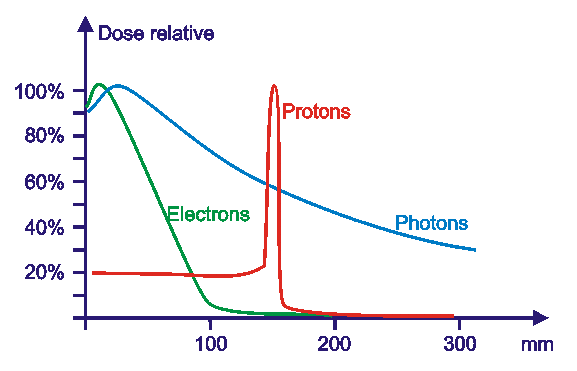Proton therapy is a precise and gentle treatment method with minimal side effects. Based on worldwide experience and long-term results in treated patients, it is clear that patients after proton treatment have a higher quality of life compared to those who have undergone conventional (photon) radiotherapy.
Although many people believe proton therapy is relatively new, it’s been around as early as 1946 with treatments on patients starting around 1954. Since then, proton therapy has evolved and expanded to many locations around the world, with the first UK proton centre for ocular tumours opening in 1989.
The Advantages of Proton Irradiation are Based on Physical Laws and Proton Properties
 Unlike conventional radiotherapy, which uses photons to irradiate and destroy tumor cells, proton therapy is more advanced and uses protons. The commonly used photon beam goes through the body and emits a significant portion of its energy both in front of and behind the tumor. However, protons have a physical property, called the Bragg peak, which has the ability to deliver significantly less energy on the way to the tumor and has no impact on the tissues behind the tumor. Thus, the greatest advantage of proton therapy compared to conventional radiotherapy is its accuracy and its ability to protect healthy tissues.
Unlike conventional radiotherapy, which uses photons to irradiate and destroy tumor cells, proton therapy is more advanced and uses protons. The commonly used photon beam goes through the body and emits a significant portion of its energy both in front of and behind the tumor. However, protons have a physical property, called the Bragg peak, which has the ability to deliver significantly less energy on the way to the tumor and has no impact on the tissues behind the tumor. Thus, the greatest advantage of proton therapy compared to conventional radiotherapy is its accuracy and its ability to protect healthy tissues.
Pencil Beam Scanning Technique
The majority of proton centres throughout the world currently use “scattered beam” nozzles to deliver the protons to cancerous tumours. While scattered beams are extremely effective, a newer generation of beam, known as “pencil beam scanning”, now allows oncologists to treat cancer patients with a higher degree of precision.
At the Prague Proton Therapy Center we use the most advanced form of proton therapy. Pencil beam scanning (PBS) marks the exact distribution of the proton beam dose and is currently the absolute peak in proton therapy technology. Pencil scanning irradiates the target area with millimeter accuracy with minimal damage to surrounding healthy tissues and organs.
To illustrate how PBS works, imagine the task of colouring in a circle on a piece of paper with a pencil. As you fill in the circle, you will focus on making sure that you do not cross the borders. PBS also focuses on staying within the borders of the area being treated. This is why side effects during proton therapy are minimal.
As respiratory movements may impair the correct and precise execution of proton irradiation, in the treatment of diagnoses such as breast cancer, lung cancer, lymphoma… we also use the method of controlled breathing.
Learn more –>
Our physicians have many years of experience in radiotherapy. Moreover, they are experienced in both standard (photon) and proton radiation therapy; therefore, they will be able to answer all your questions pertaining to your decision on your treatment.



 Robert Rathbun Wilson, PhD, has been described as “the father of proton therapy”. He learned high-energy physics at the Radiation Laboratory of Ernest O. Lawrence at the University of California, Berkeley.
Robert Rathbun Wilson, PhD, has been described as “the father of proton therapy”. He learned high-energy physics at the Radiation Laboratory of Ernest O. Lawrence at the University of California, Berkeley.